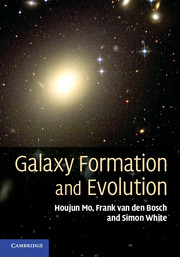Book contents
- Frontmatter
- Contents
- Preface
- 1 Introduction
- 2 Observational Facts
- 3 Cosmological Background
- 4 Cosmological Perturbations
- 5 Gravitational Collapse and Collisionless Dynamics
- 6 Probing the Cosmic Density Field
- 7 Formation and Structure of Dark Matter Halos
- 8 Formation and Evolution of Gaseous Halos
- 9 Star Formation in Galaxies
- 10 Stellar Populations and Chemical Evolution
- 11 Disk Galaxies
- 12 Galaxy Interactions and Transformations
- 13 Elliptical Galaxies
- 14 Active Galaxies
- 15 Statistical Properties of the Galaxy Population
- 16 The Intergalactic Medium
- A Basics of General Relativity
- B Gas and Radiative Processes
- C Numerical Simulations
- D Frequently Used Abbreviations
- E Useful Numbers
- References
- Index
2 - Observational Facts
Published online by Cambridge University Press: 05 June 2012
- Frontmatter
- Contents
- Preface
- 1 Introduction
- 2 Observational Facts
- 3 Cosmological Background
- 4 Cosmological Perturbations
- 5 Gravitational Collapse and Collisionless Dynamics
- 6 Probing the Cosmic Density Field
- 7 Formation and Structure of Dark Matter Halos
- 8 Formation and Evolution of Gaseous Halos
- 9 Star Formation in Galaxies
- 10 Stellar Populations and Chemical Evolution
- 11 Disk Galaxies
- 12 Galaxy Interactions and Transformations
- 13 Elliptical Galaxies
- 14 Active Galaxies
- 15 Statistical Properties of the Galaxy Population
- 16 The Intergalactic Medium
- A Basics of General Relativity
- B Gas and Radiative Processes
- C Numerical Simulations
- D Frequently Used Abbreviations
- E Useful Numbers
- References
- Index
Summary
Observational astronomy has developed at an extremely rapid pace. Until the end of the 1940s observational astronomy was limited to optical wavebands. Today we can observe the Universe at virtually all wavelengths covering the electromagnetic spectrum, either from the ground or from space. Together with the revolutionary growth in computer technology and with a dramatic increase in the number of professional astronomers, this has led to a flood of new data. Clearly it is impossible to provide a complete overview of all this information in a single chapter (or even in a single book). Here we focus on a number of selected topics relevant to our forthcoming discussion, and limit ourselves to a simple description of some of the available data. Discussion regarding the interpretation and/or implication of the data is postponed to Chapters 11-16, where we use the physical ingredients described in Chapters 3-10 to interpret the observational results presented here. After a brief introduction of observational techniques, we present an overview of some of the observational properties of stars, galaxies, clusters and groups, large scale structure, the intergalactic medium, and the cosmic microwave background. We end with a brief discussion of cosmological parameters and the matter/energy content of the Universe.
- Type
- Chapter
- Information
- Galaxy Formation and Evolution , pp. 25 - 99Publisher: Cambridge University PressPrint publication year: 2010



